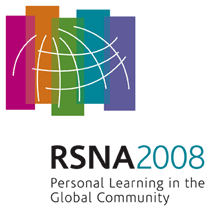
Abstract Archives of the RSNA, 2008
SSQ01-03
Noninvasive 3.0 T DWI, MRS, and DCE-MRI Techniques for Early Assessment of Response to Neoadjuvant Chemotherapy in Locally Advanced Breast Cancer
Scientific Papers
Presented on December 4, 2008
Presented as part of SSQ01: ISP: Breast Imaging (MR Imaging Techniques)
Qing Yuan PHD, Abstract Co-Author: Nothing to Disclose
Gary Jacob Whitman MD, Presenter: Nothing to Disclose
Huong Thien Le-Petross MD, Abstract Co-Author: Nothing to Disclose
Massimo Cristofanilli MD, Abstract Co-Author: Nothing to Disclose
Eleni Andreopoulou MD, Abstract Co-Author: Nothing to Disclose
Edward F. Jackson PhD, Abstract Co-Author: Nothing to Disclose
The goal of this study was to integrate diffusion weighted imaging (DWI), spectroscopy, and dynamic contrast enhanced (DCE) MR techniques and quantitative analysis tools into clinical 3T MR exams to allow early assessment of cellular, biochemical, and microvascular changes in locally advanced breast cancer (LABC) patients undergoing neoadjuvant chemotherapy (NAC).
In this ongoing study, 13 patients with LABC (IIA-B, IIIA-C) consented and completed at least 2 exams (prior to and 1 cycle after the initiation of chemotherapy) on a 3T GE HDx scanner with an 8-channel breast coil. DWI series were acquired using a single-shot spin-echo echo-planar sequence (TE/TR=84/6000ms). In order to maintain a fixed TE value, the diffusion tensor file, which controls the diffusion gradients, was modified to acquire DW images along three axes with variable b-values (~0, 500, 1000, and 1500 s/mm2). The DW images were then combined and pixel-by-pixel ADC values were calculated using regression analysis. DCE-MRI series were acquired using a 3D fast spoiled gradient echo (FSPGR) sequence (α/TE/TR=15o/2.7/6.4ms) before, during, and following bolus injection of GdDTPA (16 slices, temporal resolution of 7-9 s, scan time of 6 minutes). Native T1 mapping was obtained using a 3D FSPGR sequence with 6 flip angles (α=5~29o). Toft’s model was used to calculate pixel-by-pixel Ktrans values. Single voxel BREASE MRS was acquired using TE/TR=155/2000ms.
Comparing tumor results from cycle1 to baseline, the mean Ktrans decreased 36.9% (N=13) and the mean ADC increased 9.5% (N=11). In patients who demonstrated an initial choline peak (CP), the CP decreased at cycle1 in all cases but one. Thus far, 5 patients have completed NAC and proceeded to surgery. One patient, whose disease progressed, demonstrated a 52.9% increase in Ktrans at cycle1 and a persistent CP. The other 4 patients, who responded to NAC, showed a 58.3% decrease in Ktrans.
We have integrated multi-b-value DWI, MRS, and high spatial-/temporal-resolution DCE-MRI techniques into clinical MR exams to monitor NAC in LABC. Our results demonstrate decreases in Ktrans and increases in ADC as early indicators of response after 1 cycle of NAC.
Changes in quantitative DCE, MRS, and DWI parameters can assess early response of breast cancer to NAC and potentially differentiate responders from non-responders early in the course of NAC.
Yuan, Q,
Whitman, G,
Le-Petross, H,
Cristofanilli, M,
Andreopoulou, E,
Jackson, E,
Noninvasive 3.0 T DWI, MRS, and DCE-MRI Techniques for Early Assessment of Response to Neoadjuvant Chemotherapy in Locally Advanced Breast Cancer. Radiological Society of North America 2008 Scientific Assembly and Annual Meeting, February 18 - February 20, 2008 ,Chicago IL.
http://archive.rsna.org/2008/6008375.html

